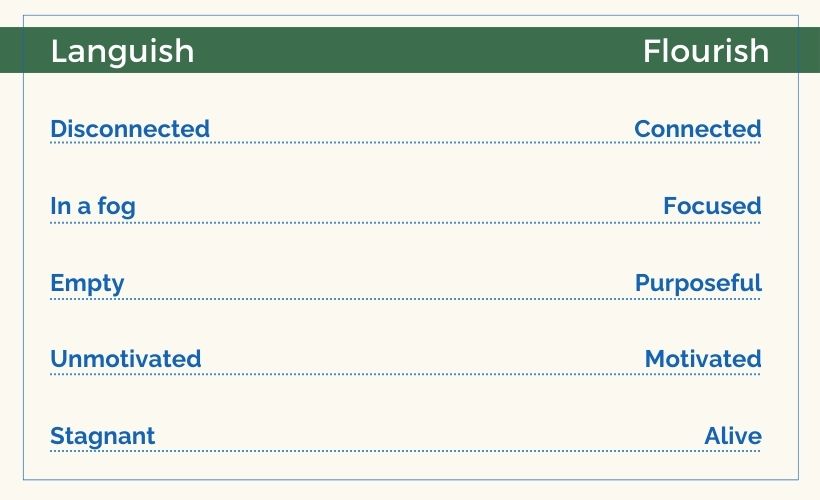How to Be Happier (Instead of Languishing) - Lisa E Betz
On my recent survey, over 50 % reported they feel like they’re just going through the motions in life. Perhaps you feel that way, too. Do you feel stuck in a rut, blah, unmotivated, merely existing instead of really living? Therapists have a term for this state—languishing. It’s the opposite of a joy-filled, flourishing life.
When we’re stuck in languishing, we can manage life, but we’re missing the joy, purpose and other factors that help us to thrive or feel happy.
Languishing vs Flourishing
“Languishing can be defined as a pervasive feeling of blah-ness that dulls your motivation. The feeling can follow you throughout your day, holding you back from the flourishing life you want.” BetterUp.com
Psychologist Corey L. M. Keyes described languishing as “emptiness and stagnation, constituting a life of quiet despair…”
Flourishing, on the other hand, is “the pursuit and engagement of an authentic life that brings inner joy and happiness through meeting goals, being connected with life passions, and relishing in accomplishments through the peaks and valleys of life.” Dr. Lynn Soots
I sometimes feel like my life is languishing instead of flourishing. I don’t want to stay in a blah, unmotivated, funk, and I’m sure you don’t either. So let’s take a look at the symptoms of languishing and how to move away from them toward a happier, more flourishing state.
The main components of languishing
The symptoms of languishing fall into 5 major categories.
- Disconnected – withdrawn, alone, unsupported, isolated, lacking solid and vibrant relationships.
- In a fog – lacking direction in life, pulled it too many directions, adrift, fuzzy priorities, lacking perspective.
- Empty – lacking purpose and meaning, blah, hopeless, without color, beauty, or vibrancy. What’s the point?
- Unmotivated – uninspired, lukewarm, disillusioned, lacking the energy or gumption to do things. Why bother?
- Stagnant – feeling stuck, unable to grow or change, unimaginative, bored, boxed in.
The main components of flourishing
In contrast, the descriptors of a state of flourishing include:
- Connected – Enjoying mutually supportive relationships, feeling accepted, seen and loved.
- Focused – having clarity about what matters or what you are called to accomplish, a sense of direction and perspective even when the specific steps aren’t clear.
- Purposeful – believing that you matter, and you can make a difference. Faith and hope that life is worth living and God answers prayers even when we can’t see him working.
- Motivated – feeling confident and able to pursue important things, willing to tackle hard choices and make worthwhile lifestyle changes.
- Alive – feeling a zest for life, eager to grow and change, filled with creativity, imagination, and a willingness to try new things.
We all fall somewhere in the gap between these opposite states.
Where do you fall in the spectrum between languishing and flourishing? Locate where you feel you are today in each spectrum. Download this worksheet if you prefer to work on paper, or to share it with a friend.

This simple assessment gives you a baseline and highlights which areas you want to improve. Here’s how.
Moving toward flourishing (or How to be happier)
How do we move away from the blah state of languishing to a happier, joy-filled state of flourishing? By taking small, intentional steps to move toward the positive side. Here is a list of two actions you can take in each of the five spectrums to move a little bit closer to flourishing.
Connection
Think about 2-3 people you care about very much. Make a point of connecting with them today. This might be sending a text or sitting down after dinner and asking them what’s on their mind.
Have you gotten out of the habit of attending a group, church service, or exercise class? This is the week to return and begin reconnecting with people and activities you enjoy.
Focus
Be honest about your feelings (just to yourself). Your heart and body know when you’re being dishonest about what you’re feeling, and this disconnect between your emotions and what you pretend to feel is draining and confusing.
Identify one thing that drags your thoughts or emotions down. Take steps to eliminate it or limit its influence. This could be a specific show, a type of music, a particular group, or even a piece of art hanging on your wall that triggers a negative reaction.
Purpose
Think through the various activities that fill your week. Name one that particularly excites you or gives you a reason to wake up in the morning. Journal or share with a friend about the activity and how it makes you feel.
Spend a few moments every day practicing gratitude. For guidance or ideas, read this post.
Motivation
Plan something fun for next weekend (or tonight). Having something to look forward to helps you get motivated for the rest of life, too.
Set a tiny goal and tell a friend when you achieve it. This might be making a phone call or filing ten documents. Every good action counts.
Live fully
Add something simple to your home or work space that makes you smile. A photo, a silly doodad, a vase of flowers, or a child’s artwork.
Get moving. Take a few minutes to do some kind of movement that you find fun. Dance, sway, stretch, or just move randomly as the spirit flows. But remember, the intent is to ENJOY it, not to get fit, lose weight, or achieve your 10,000 steps goal for the day.






